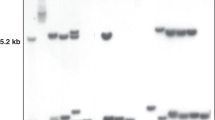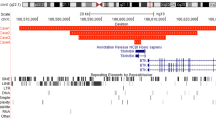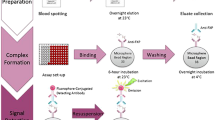Abstract
THE fragile-X syndrome is the most frequent inherited form of mental retardation, with an incidence of 1 in 1,500 males. It is characterized by the presence of a fragile site at Xq27.3 induced in vitro by folate deprivation or by inhibitors of deoxynucleotide synthesis1. Its mode of inheritance is unusual for an X-linked trait, with incomplete penetrance in both males and females. Some phenotypically normal males transmit the mutation to all their daughters who rarely express any symptoms, but penetrance is high in sons and daughters of these carrier women2. Genetic and physical mapping of the Xq27-q28 region has confirmed that the disease locus is located at or very near the fragile site3–6. Hypotheses proposed to account for the abnormalities in the inheritance of the disease include sequence rearrangements by meiotic recombination1,7,8 or a mutation that affects reactivation of an inactive X chromosome during differentiation of female germ cells9,10. To detect such rearrangements, or methylation changes that may reflect a locally inactive X chromosome, we used pulsed-field gel analysis of DNA from fragile-X patients with probes close to the fragile-X locus. The probe Do33 (DXS465) detected abnormal patterns in fragile-X patients, but not in normal controls or in non-expressing male transmitters.
This is a preview of subscription content, access via your institution
Access options
Subscribe to this journal
Receive 51 print issues and online access
$199.00 per year
only $3.90 per issue
Buy this article
- Purchase on Springer Link
- Instant access to full article PDF
Prices may be subject to local taxes which are calculated during checkout
Similar content being viewed by others
References
Nussbaum, R. L. & Ledbetter, D. H. A. Rev. Genet. 20, 109–145 (1986).
Sherman, S. L. Jacobs, P. A. Morton, N. E., Froster-Iskenius, U. & Howard-Peebles, P. N. Hum. Genet. 69, 289–299 (1985).
Oberlé, I. et al. Proc. natn. Acad Sci. U.S.A. 83, 1016–1020 (1986).
Suthers, G. K. et al. Science 246, 1298–1300 (1989).
Suthers, G. K. et al. Am. J. hum. Genet. 47, 187–195 (1990).
Rousseau, F. et al. Am. J. hum. Genet. 48, 108–116 (1991).
Pembrey, M. E., Winter, R. & Davies, K. Am. J. med. Genet. 21, 709–717 (1985).
Ledbetter, D. H., Ledbetter, S. A. & Nussbaum, R. L. Nature 324, 161–163 (1986).
Laird, C. D. Genetics 117, 587–599 (1987).
Laird, C. D., Lamb, M. M. & Thorne, J. L. Am. J. hum. Genet. 46, 696–719 (1990).
Warren, S. T. et al. Proc. natn. Acad Sci. U.S.A. 87, 3856–3860 (1989).
Suthers, G. K. et al. Am. J. hum. Genet. (in the press).
Bird, A. P. Trends Genet. 3, 342–347 (1987).
Southern, E. M., Anand, R., Brown, W. R. A. & Fletcher, D. S. Nucleic Acids Res. 15, 5925–5943 (1987).
Author information
Authors and Affiliations
Rights and permissions
About this article
Cite this article
Vincent, A., Hertz, D., Petit, C. et al. Abnormal pattern detected in fragile-X patients by pulsed-field gel electrophoresis. Nature 349, 624–626 (1991). https://doi.org/10.1038/349624a0
Received:
Accepted:
Issue Date:
DOI: https://doi.org/10.1038/349624a0
This article is cited by
-
Case-control meta-analysis of blood DNA methylation and autism spectrum disorder
Molecular Autism (2018)
-
Leveraging blood serotonin as an endophenotype to identify de novo and rare variants involved in autism
Molecular Autism (2017)
-
MBD5 haploinsufficiency is associated with sleep disturbance and disrupts circadian pathways common to Smith–Magenis and fragile X syndromes
European Journal of Human Genetics (2015)
-
FMRP targets distinct mRNA sequence elements to regulate protein expression
Nature (2012)
-
A unique case of reversion to normal size of a maternal premutation FMR1 allele in a normal boy
European Journal of Human Genetics (2008)
Comments
By submitting a comment you agree to abide by our Terms and Community Guidelines. If you find something abusive or that does not comply with our terms or guidelines please flag it as inappropriate.



